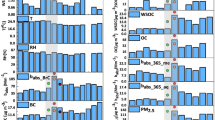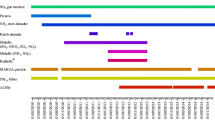Abstract
The halogen ions Br- and Cl- together with NO3 -, SO4 =, MSA- (methane sulfonate), Na+ and NH4 + were analysed by ion chromatography in extracts of more than 800 aerosol cellulose filter samples taken at Ny Ålesund, Svalbard (79°N, 12°E) in spring 1996 (March 27 - May 16) within the European Union project ARCTOC (Arctic Tropospheric Ozone Chemistry). Anticorrelated variations between f-Br (filterable bromine, i.e. water soluble bromine species that can be collected by aerosol filters) and ozone within the arctic troposphere were evaluated at a resolution of 1 or 2 hours for periods with depleted ozone and 4 hours at normal ozone. A mean f-Br concentration of 11 ng m-3 (0.14 nmol m-3) was observed for the whole campaign, while maximum concentrations of 80 ng m-3 (1 nmol m-3) were detected during two total O3-depletion events (O3 drop to mixing ratios below the detection limit of < 2 ppb). Anticorrelation between f-Br and O3 was also seen during minor O3-depletion episodes (sudden drop in O3 by at least 10 ppb, but O3 still exceeding the detection limit) and even for ozone variations near its background level (40-50 ppb). A time lag of about 10 hours between the change of ozone and of f-Br concentrations could only be found during a total ozone depletion event, when f-Br reached its maximum values several hours after ozone was totally destroyed. Bromine oxide (BrO) concentrations, measured by DOAS (Differential Optical Absorption Spectroscopy), and f-Br showed a coincident variability during almost the entire campaign (except in the case of total O3-loss). Frequently enhanced anthropogenic nitrate and sulphate concentrations were observed during O3-depletion periods. At O3 concentrations < 10 ppb sulphate and nitrate exceed their typical mean level by 54% and 77%, respectively. This may indicate a possible connection between acidity and halogen release.
Similar content being viewed by others
References
ARCTOC Final Report, 1997: ARCTOC Final Report to the European Commision, Arctic Tropospheric Ozone Chemistry, ARCTOC Final Report, EUR 17783 EN, Platt U. and Lehrer E. (Eds.), Contract No. EV5V-CT93-0318 (DTEF).
Barrie L.A., A.M. Li, D.L. Toom, S. Landsberger and W. Sturges, 1994: Lower tropospheric mesurements of halogens, nitrates and sulphur oxides by denuder and filter systems during Polar Sunrise Experiment: 1992, J. Geophys. Res., 99(D12), 25,453-25,468.
Barrie L.A., Bottenheim J.W., Schnell R.C., Crutzen P.J. and Rasmussen R.A.: 1988, Ozone destruction and photochemical reactions at polar sunrise in the lower Arctic atmosphere, Nature, 334, 138-141.
Bedjanian Y., Poulet G. and Le Bras G.: 1998 Reactions of bromine atoms with alkenes: kinetics and mechanisms at low pressure. Poster presented at EGS, Nice 1998.
Berg W.W., Speery P.D., Rahn K.A., Gladney E.S.: 1983, Atmospheric bromine in the Arctic, J. Geophys. Res., 88(C11), 6719-6736.
Borken J.: 1996, Ozonabbau durch Halogene in der arktischen Grenzschicht: Reaktionskinetische Modellrechnungen zu einem Frühjahrsphänomen. Diploma Thesis, University of Heidelberg.
Bottenheim J.W., Barrie L.W., Atlas E., Heidt L.E., Niki H., Rasmussen R.A. and Shepson P.B.: 1990, Depletion of lower tropospheric ozone during Arctic spring: The Polar Sunrise Experiment 1988, J. Geophys. Res., 95(D11), 18555-18568.
Crowley J.N., Fickert S., Adams J. and Moortgat G.: 1998, Sea-Salt Aerosols: Laboratory Investigations of Heterogeneous Halogen Activation in the Troposphere (SALT), Progress Report No 2 to EU.
De Serves C.: 1994, Gas phase formaldehyde and peroxide measurements in the Arctic atmosphere. J. Geophys. Res., 99(D12), 25391-25398.
Fan S.-M. and Jacob D. J.: 1992, Surface ozone depletion in Arctic spring sustained by bromine reactions on aerosols, Nature, 359, 522-524.
Finlayson-Pitts B. J., Livingston F. E. and Berko H. N.: 1990, Ozone destruction and bromine photochemistry at groundlevel in the Arctic spring, Nature, 343, 622-625.
Hausmann M. and Platt U.: 1994, Spectroscopic measurement of bromine oxide and ozone in the high Arctic during Polar Sunrise Experiment 1992, J. Geophys. Res., 99(D12), 25,399-25,414.
Kreher, K., Johnston, P. V., Wood, S. W., Nardi, B. and Platt, U.: 1997, Ground-based measurements of tropospheric and stratospheric BrO at Arrival Heights, Antarctica. Geophys. Res. Lett., 24, 3021-3024.
Langendörfer U, 1997: Hochaufgelöste chemische Charakterisierung des arktischen Aerosols und dessen Deposition während troposphärischer Niedrigozonepisoden, Diploma Thesis, University of Heidelberg.
Le Bras G. and Platt U., 1995: A possible mechanism for combined chlorine and bromine catalyzed destruction of tropospheric ozone in the Arctic, Geophys. Res. Lett., 22, 599-602.
Lehrer E., 1995: Variabilität der arktischen Aerosolchemie im Verlauf troposphärischer Ozonabnahme-Episoden, Diploma Thesis, University of Heidelberg.
Lehrer E., Wagenbach D. and Platt U., 1997: Chemical aerosol composition during tropospheric ozone depletion at Ny-Ålesund/Svalbard, Tellus, 49B(5), 486-495.
Li, S.M. and Barrie L.A., 1993: Biogenic sulphur aerosols in the Arctic troposphere: 1. Contributions to sulphate, J. Geophys. Res., 98(D11), 20613-20622.
Maenhaut W., Beyaert K., Ducastel G., Havránek V., Salomonovic R. and Hanssen J.E., 1997: Long-term measurements of the atmospheric aerosol composition at Ny Ålesund, Spitsbergen. A contribution to subproject ASE. Proceedings of EUROTRAC Symposium '96 Volume 1, Borell P.M., Borell P., Cvitaš T., Seiler W. (Eds.).
Murayama S., Nakazawa T., Tanaka M., Aoki S. and Kawaguchi S., 1992: Variations of tropospheric ozone concentrations over Syowa Station, Antarctica. Tellus, 44B, 262-272.
Oltmans S.J. and Komhyr W.D., 1986: Surface ozone distributions and variations from 1973–1984 measurements at the NOAA geophysical momitoring for climatic change baseline observatories. J. Geophys. Res., 91(D4), 5229-5236.
Solberg S., Schmidbauer, N., Semb, A. and Stordal, F., 1996: Boundary-layer ozone depletion in the Norwegian Arctic in spring., J. Atmos. Chem., 23, 301-332.
Solomon S., Garcia R.R., Ravishankara A.R. 1994: On the role of iodine in ozone depletion, J. Geophys. Res., 99(D10), 20491-20499.
Sturges W.T., Schnell R.C., Dutton G.S., Garcia S.R. and Lind J.A., 1993: Spring measurements of tropospheric bromine at Barrow, Alaska., Geophys. Res. Lett., 20, 201-204.
Tuckermann M., 1996: Troposphärische DOAS-Messungen zum halogen-katalysierten Ozonabbau im arktischen Frühjahr (Ny Ålesund, Svalbard), Diploma Thesis, University of Heidelberg.
Tuckermann M., Ackermann R., Gölz C., Lorenzen-Schmidt H., Senne T., Stutz J., Trost B., Unold W. and Platt U., 1997: DOAS-observations of halogen radical-catalysed arctic boundary layer ozone destruction during ARCTOC-campaigns 1995 and 1996 in Ny Ålesund, Spitsbergen. Tellus, 49B(5), 533-555.
Vogt R., Crutzen P.J. and Sander R., 1996: A mechanism for halogen release from sea-salt aerosol in the remote marine boundary layer, Nature, 383, 327-330.
Wagenbach D., Görlach U., Moser K., Münnich K.O., 1988: Coastal Antarctic aerosol: the seasonal pattern of its chemical composition and radionuclide content, Tellus, 40B, 426-436.
Wessel S., 1996: Troposphärische Ozonvariation in Polarregionen, Ph.D. Thesis, University of Bremen
Wessel S., Aoki S., Winkler P., Weller R., Herber A., Gernandt H. and Schrems O., 1998: Troposheric ozone depletion in polar regions. A comparison of observations in the Arctic and Antarctic, Tellus, 50B, 34-50.
Wilson T.R.S., 1975: Salinity and the major elements of seawater, Riley J.P., Skirrow G. (Eds.) Chemical Oceanography, 1, 365-389.
Author information
Authors and Affiliations
Rights and permissions
About this article
Cite this article
Langendörfer, U., Lehrer, E., Wagenbach, D. et al. Observation of Filterable Bromine Variabilities During Arctic Tropospheric Ozone Depletion Events in High (1hour) Time Resolution. Journal of Atmospheric Chemistry 34, 39–54 (1999). https://doi.org/10.1023/A:1006217001008
Issue Date:
DOI: https://doi.org/10.1023/A:1006217001008




